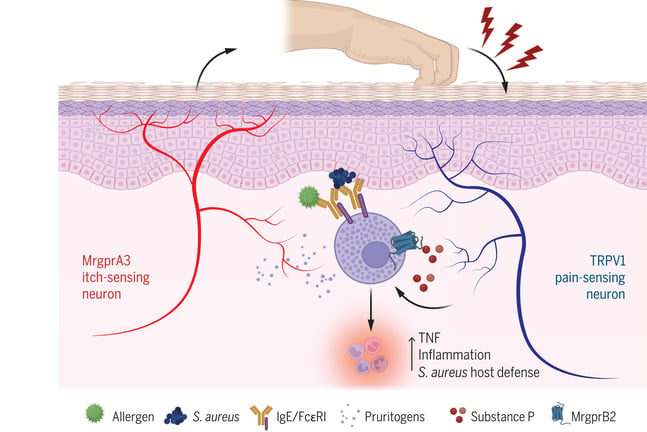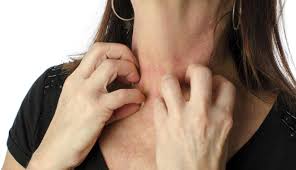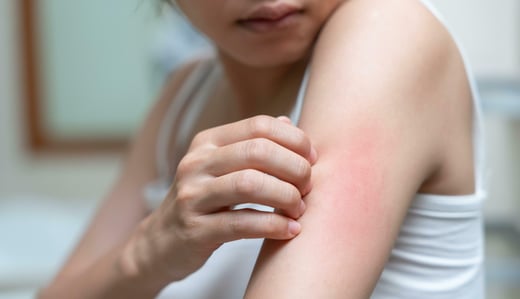"CONNECTING RESEARCH TO REALITY"
Scratching Triggers Allergies by Activating Nerves and Immune Cells
Scratching activates neutrophils, mast cells, and TRPV1, aiding immune defense but worsening inflammation. Excessive scratching disrupts the skin barrier, leading to chronic issues. Learn How Scratching Triggers Allergies by Activating Nerves and Immune Cells.
BLOGS-RATHBIOTACLAN
𝐒𝐇𝐈𝐁𝐀𝐒𝐈𝐒 𝐑𝐀𝐓𝐇
2/14/20253 min read


Scratching synergizes with FcεRI mast cell activation to drive allergic skin inflammation.
Cross-linking of FcεRI or IgE on mast cells by allergens or S. aureus activates mast cell release of pruritogens (itch-inducing factors) that are sensed by MrgprA3-expressing neurons. Scratching resulting from itch sensation activates Trpv1-expressing neurons to release the neurotransmitter SP. SP acting through MrgprB2 on mast cells synergizes with FcεRI to enhance mast cell release of TNF, resulting in enhanced cutaneous inflammation and increased S. aureus host defense. [Figure created with BioRender.com]
Credit: Published On Science.org
Scratching
A Two-Edged Sword in Inflammation and Immunity of the Skin
Scratching is a longstanding itch response, a sensory reflex mechanism evolved as protection against irritants, parasites, and infection. Persistent scratching then comes to be perceived as pathological, particularly in inflammatory dermatological disease such as atopic dermatitis (AD). Despite causing irritation to the skin barrier and activating inflammation, scratching also has a previously unknown role in infection protection based on a study last year by the University of Pittsburgh School of Medicine, which suggests it could also help attract neutrophils during bacterial infection.
Central to this study is the role of specialized itch-sensing neurons, nonpeptidergic (NP2) neurons, that are sensitive to mechanical and chemical stimuli. These neurons possess receptors such as Mas-related G protein-coupled receptor A3 (MrgprA3) and MrgprC11, which belong to histaminergic and non-histaminergic pathways of itch.
When the skin is scratched, NP2 neurons are stimulated and release substance P (SP). The neuropeptide stimulates NK1 receptors of mast cells to degranulate and release histamine, tumor necrosis factor-alpha (TNF-α), interleukin-6 (IL-6), and prostaglandins. Inflammatory mediators induce vasodilation, increase vascular permeability, and chemotactically attract neutrophils—the body's first defense against bacterial invasion.
In addition, scratching stimulates transient receptor potential (TRP) receptors, e.g., TRPV1 and TRPA1, which augment pain perception and thus enhance neurogenic inflammation.
This positive feedback is the explanation for why scratching becomes a compulsive action in conditions such as chronic pruritus.
Scratching and Infection:
An Evolutionary Immune Response?
The research revealed a shocking finding that scratching augments immune defense against bacterial infection. In NP2 neuron-deficient genetically altered mice, the investigators discovered that these animals had reduced neutrophil mobilization during exposure to skin irritation, thus carrying a greater burden of bacteria during Staphylococcus aureus (S. aureus) exposure. Healthy mice that scratched, on the contrary, had improved neutrophil infiltration, therefore preventing bacterial colonization. This implies that scratching is an immune protective response in health, recruiting neutrophils to areas of possible infection. But this protective effect has its limitations.
With scratching too vigorous, it is at the cost of the stratum corneum, the outer epidermal layer, that epidermal barrier disruption is caused. It provides a portal of entry to opportunistic microorganisms such as S. aureus to invade deeper into the skin, causing chronic inflammation and microbial dysbiosis.
Why Do We Scratch?
The Evolutionary Perspective says, the continued existence of scratching behavior indicates that it might have an evolutionary role to play. In primitive man, inflammation of the skin tended to come before parasitic infections, insect bites, or minor trauma, all of which were infection risks. Inflammation caused by scratching might have offered an immediate immune reaction to increase survival opportunities by deterring bacterial growth. Yet, in today's environments, with inflammatory skin disorders such as eczema and psoriasis reigning supreme, such a response is adaptive. The same immune responses that protected earlier against infection are now leading to chronic inflammation, impairment of the skin barrier, and sensitization to allergens.


Rethinking Itch and Inflammation Treatments
This research questions traditional dermatologic strategies aimed at fully suppressing itch-related behaviors. Excessive scratching is detrimental, but selective modulation of NP2 neurons, substance P, or NK1R signaling may provide therapeutic avenues that:
Conserve immune-enhancing effects of scratching by preserving neutrophil recruitment.
Mitigate chronic inflammation without sacrificing pathogen defense.
Evolve targeted treatments that block neurogenic inflammation but enhance skin barrier repair.
Newer therapies like NK1R antagonists (e.g., aprepitant), TRPV1 blockers, and anti-MrgprA3 monoclonal antibodies could represent novel modalities to modulate the itch-immune response.
Scratching as a Complex Immunological Response
This research redirects the understanding of scratching from an injurious reflex to a biologically important immune mechanism. Excessive scratching is a defining characteristic of inflammatory dermatoses, yet its neutrophil recruitment and antimicrobial capacities imply an evolved functional role. Subsequent research could further tailor treatments to weigh immune defense against inflammation suppression, opening up new therapeutic options for dermatology and immunology.


JOURNAL REFERENCES:
Published On Science.org
Liu, A. W., et al. (2025). Scratching promotes allergic inflammation and host defense via neurogenic mast cell activation.
https://www.science.org/doi/10.1126/science.adn9390
Vol 387, Issue 6733
DOI: 10.1126/science.adn9390
ADVERTISEMENTS
ADVERTISEMENTS
ADVERTISEMENTS
ADVERTISEMENTS
ADVERTISEMENTS
ADVERTISEMENTS

Drop Us a Line
We’d Love to Hear from You
RATHBIOTACLAN
Feel free to explore, engage, and embark on your own journey of discovery within RathBiotaClan. Together, let's make a difference in the world of Zoology_Bioscience !
